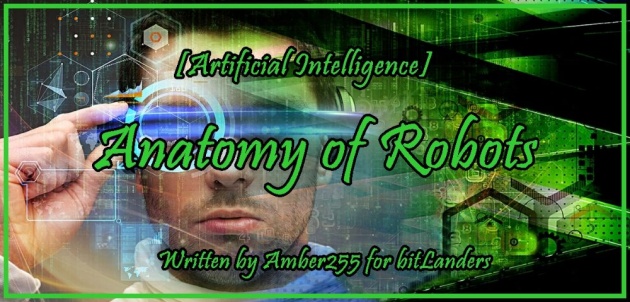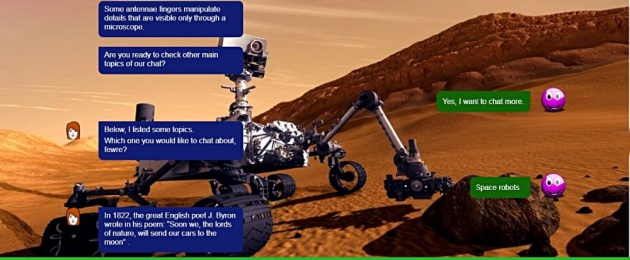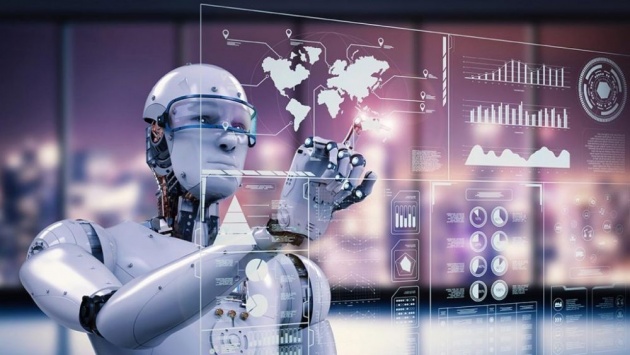
[Artificial Intelligence] Anatomy of Robots - Photo credit: behance, edition by Amber255 via bitLanders
The present century has many names: atomic age, space-age, age of electronics. With no less reason, you can call it the age of robots. More recently, these devices existed only on the pages of science fiction books. Today, at many of our enterprises, robots actively help people in their hard work.
The fact is that robots free people from monotonous uninteresting labor, taking it on their iron shoulders.
But facilitating the work of people is not the only merit of robots. The use of robots increases labor productivity by 2-3 times. The introduction of one robot can give an economic effect of millions of dollars.
An important factor in the development of our world is the maximum use of the achievements of science and technology. The scientific and technological revolution and social progress play an increasingly important role in the daily life of millions of people. We have constantly improved technology and production. Now the widespread use of industrial robots is put in the first place among the urgent economic problems associated with the implementation of science in practice.
Robots and AI bring the left-brain thinking, leaving room for human staff to bring the right-brain thinking. Robots cannot imitate creative thinking. The human side will still bring the ideas and the innovation, while the robotic and AI side will bring the efficiency with streamlined processes, the help with the heavy lifting and systematic thinking.
Credits: mci-group
Shortly, entire plants will be created where robots will be engaged in all work, from design and production planning to packaging of finished products. By the way, such automated production is becoming a fact of the present day: fully automated workshops already produce products.
Robots are human helpers
What, besides facilitating working conditions, will a person gain by transferring part of his duties to the shoulders of robots? A lot of things. First of all, the use of modern automatic manipulators, in the full sense of the word thinking, self-learning machines, makes it possible to quickly restructure production to produce new products.
The use of robots opens up prospects for the creation of fundamentally new technological processes where direct human participation is impossible. For example, a person in a 100 grades centigrade heat or, say, in conditions of strong radiation can not work, but a robot can.
The complex use of industrial robots already today allows increasing labor productivity by a few times.
And finally - a social factor. Robots will take on almost all unskilled labor. They replace a person with hard, dangerous, monotonous, uninteresting work, and a person has become a qualified operator, who manages them, trains them. and sets them up. The robot does not need housing, transport to get to work, it does not feel a cold, it does not go on vacation. In short, a lot of what a person needs, a robot does not need. It needs a man who knows it well and knows how to manage it.
Artificial Intelligence Robots Development Until 2019 - Video credit: youtube
We need competent, highly qualified engineers, technicians, and workers. A qualitatively new level of operator training is needed. Now, specialists in robotics have begun to train in a lot of technical universities in many countries.
Robots are increasingly confidently entering our lives. We need to prepare for a meeting with them; we need to learn how to use them. They are already a reality, but very often new, fantastic ideas are embodied in them. And of course, we cannot but be interested in such machines no matter what profession they intend to choose in the future.
An inquiring mind seeks answers to dozens of questions when meeting with any machine, whether it be a simple watch - walkers or a powerful rocket. Robots are of particular interest. How are they arranged? How do they work? Are they capable of replacing a person? Is it possible to build a robot with your own hands, or at least it is a model? The last question is of particular concern to young lovers of technology, inquisitive enthusiasts, those who with enthusiasm invent, construct, assemble.
The sooner our future designers of intelligent machines master the ABC of robotics on the simplest models, the more they will teach robotics specialists in the future. Life shows that the creation of many elements of robots and their models is quite accessible to schoolchildren.
Robots quickly penetrate into all spheres of everyday activity: transport, agriculture, medicine, many fields of science. Very soon they will come to our life, to our house. To make them your friends, you need to know them.
So, for more info about robots, just check my new Querlo and find what I share on these topics:
1. Robot arm 2. First Generation Robots - Trained Manipulators 3. Space robots
4. Robots in agriculture 5. Domestic robots 6. Robots - objects of increased danger
7. Robots for Mega World
Chat with me about Anatomy of Robots (link opens chat in a full-screen mode):
Perhaps at the enterprises of the future, a sign will be hung at the entrance: People are strictly forbidden! Today we often encounter a situation when a person, due to his limited physical and mental qualities, becomes a brake on the development of production, forcing to pay for his presence at the factory or in the workshop to create acceptable working conditions. Robotization removes these limitations and thereby paves the way for high-quality transformations in the production sphere.
In the workshops of the factory with no humans, you can install machines that do not need aesthetic design. This will reduce the cost of machine tools by almost a third. It will take much less metal, plastics, other materials. The operator, remote from the machine, will be in comfortable conditions, and the machines can be placed directly on the floor, and not raise their bed to the level of human hands, which is now built of a lot of metal.
In an automatic workshop, one can reduce not only the general requirements for aesthetic design but also the air environment of the workshop, significantly reduce and reorganize its area and volume. Such a workshop does not necessarily have to not only ventilate (recall an expensive fan system) but also illuminate - because the robot can use ultrasonic or infrared vision.

[Artificial Intelligence] Anatomy of Robots - Photo credit: querlo
In such a factory, a robot can simply be turned off, like a vacuum cleaner or a radio, when there is no need for it, and turned on again - when the need appears. First of all, such a factory is inherent in flexibility; secondly, adaptability to new forms of management; thirdly, intelligence in the design of new products, in the planning of production.
The third-generation robot plant has a developed intellect, designs, plans and manages the production of its products, controls the accuracy and other qualities of the tools, and sends a signal to replace them.
On A Final Note
We live in the amazing 21st century, and such a thing as robots in our lives is familiar to us and not out of the ordinary. If earlier, about 50 years ago, robots were something supernatural, and notes about them could only be read on the pages of science fiction books and magazines, now robots are not new and are found everywhere.
Robots in our lives are not new, and not something unrealistic, but what we see every day. We are so used to them that we simply do not attach any importance to them. However, it is worth remembering that robots will never replace people, they are not living, but the devices we created.

[Artificial Intelligence] Anatomy of Robots - Photo credit: charteredaccountantsworldwide
Of course, we can and will continue to use robotics, but we must understand that robots are nothing compared to human genius. And what will happen with robots and people, we will see soon.
************************************************************************
****************************************************************
****************************************
I invite you to participate in Bitlanders AI-themed Blogging and create your own AI-themed blogs and C-blogs on artificial intelligence theme:
bitLanders AI-themed blogging
After the successful launch of "The bitLanders C-blogging", conversational AI blogging by Querlo powered by IBM Watson and Microsoft Azure. bitLanders continues to support its joint venture Querlo. We believe in our mission to promote our future - Artificial Intelligence (AI) - and build AI conversations via blogging, here we are to introduce "bitLanders AI-themed blogging!"Credit: quote from bitLanders
Always welcome back to check more Querlo Chat blogs on Artificial Intelligence theme.
***************************************************************************************************
Thank you for stopping by and reading my blog.
2019, All Rights Reserved.
You are very welcome to join Bitlanders and share your valuable knowledge and opinion.
***************************************************************************************************



